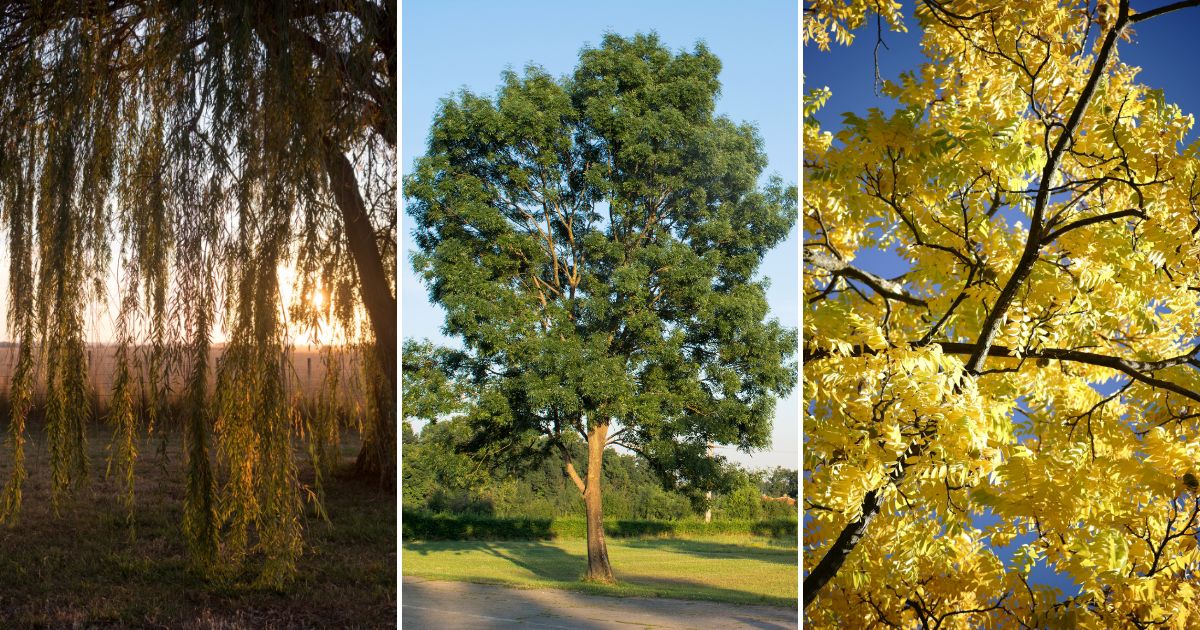Choosing the right trees for your yard is crucial for maintaining a beautiful and functional landscape.
Some trees, while beautiful or interesting, may not be suitable for residential areas due to their size, root systems, or maintenance requirements.
Here are 20 trees you might want to think twice about before planting in your yard.
1. Silver Maple
Silver Maples are known for their fast growth and shade, but their invasive root systems can damage sidewalks, driveways, and sewer lines, making them a problematic choice for yards.
2. Bradford Pear
Bradford Pears are popular for their beautiful white blooms in spring. However, their weak branch structure makes them prone to splitting during storms, posing a safety risk.
3. Black Walnut
Black Walnuts produce a chemical called juglone that can inhibit the growth of many garden plants. This allelopathic nature makes them unsuitable for yards where other plants are desired.
4. Lombardy Poplar
Lombardy Poplars grow quickly and can provide a fast screen, but they are short-lived and highly susceptible to diseases, making them a poor long-term choice.
5. Eucalyptus
Eucalyptus trees are known for their aromatic leaves and rapid growth. However, they shed bark and leaves excessively and are highly flammable, making them risky in fire-prone areas.
6. Norway Maple
Norway Maples create dense shade and their roots compete aggressively for nutrients, often making it hard for grass and other plants to thrive beneath them.
7. Mimosa
Mimosas are admired for their beautiful pink flowers, but they are invasive in many areas and prone to webworm infestations, making them a high-maintenance choice.
8. White Pine
White Pines can grow very large and are susceptible to wind damage, often losing branches during storms, which can create a mess and potential hazards in yards.
9. Ash Tree
Ash trees are susceptible to the emerald ash borer, a pest that has devastated populations across the country, leading to high removal costs and safety concerns.
10. Willow
Willows, especially Weeping Willows, require a lot of water and their extensive roots can disrupt underground pipes and cause erosion along water bodies.
11. Russian Olive
Russian Olives are highly invasive, outcompeting native plants and spreading rapidly, which can be problematic in maintaining a balanced ecosystem.
12. Siberian Elm
Siberian Elms are fast-growing but have weak wood that breaks easily. They also produce numerous seeds, making them invasive and hard to manage.
13. Tree of Heaven
Tree of Heaven grows rapidly and can spread aggressively through root suckers. Its invasive nature can quickly overpower local flora, making it unsuitable for many yards.
14. Sweetgum
Sweetgums are beautiful but their spiky seed balls can be a nuisance to clean up and may pose a tripping hazard, making them less desirable for yard planting.
15. Cottonwood
Cottonwoods produce a vast amount of fluffy seeds that can create a mess and their large size and weak wood make them prone to storm damage.
16. Holly
Holly trees can become very dense and their sharp leaves can cause injury. Additionally, their berries are toxic if ingested, posing a risk to pets and children.
17. Mulberry
Mulberries produce copious amounts of fruit that can stain surfaces and attract pests. They also have aggressive roots that can damage pavements and foundations.
18. Ginkgo (Female)
Female Ginkgo trees produce seeds that emit a strong, unpleasant odor when they fall, making them a smelly addition to any yard.
19. Sycamore
Sycamores are majestic but their shedding bark and copious leaves can create significant litter, requiring frequent cleanup in yards.
20. Boxelder
Boxelders are quick-growing but attract boxelder bugs, which can invade homes in large numbers, making them a nuisance for homeowners.




















